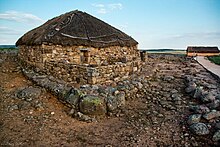Numantia
This article needs additional citations for verification. (October 2019) |
Numancia | |
 | |
| Location | Garray (Soria), Spain |
|---|---|
| Coordinates | 41°48′34.51″N 2°26′39.33″W / 41.8095861°N 2.4442583°W |
| Type | Archaeological site |
| History | |
| Cultures | Celtiberian |
| Type | Non-movable |
| Criteria | Archaeological site |
| Designated | 25 August 1882 |
| Reference no. | RI-55-0000001 |
Numantia (Spanish: Numancia) is an ancient Celtiberian settlement, whose remains are located on a hill known as Cerro de la Muela in the current municipality of Garray (Soria), Spain.[1]
Numantia is famous for its role in the
History
Numantia was an
The first serious conflict with Rome occurred in 153 BC when
In 137 BC, 20,000 Romans surrendered to the Celtiberians of Numantia (population between 4,000 and 8,000). The young Roman officer Tiberius Gracchus, as quaestor, saved the Roman army from destruction by signing a peace treaty with the Numantines, an action generally reserved for a legate.

The final siege of Numantia began in 134 BC. Scipio Aemilianus in command of an army of 30,000 soldiers laid siege to the city, erecting a 9 km barrier supported by towers, moats, impaling rods, and other devices. The Numantians refused to surrender and famine quickly spread through the city. After eight months most of the inhabitants decided to commit suicide rather than become slaves. A few hundred of the inhabitants decided to burn the city before surrendering after 13 months of siege.
Later history
After the destruction in 133 BC, occupation continued in the 1st century BC with a regular street plan but without great public buildings. Its decay started in the 3rd century, but was still settled in the 4th century.
Later remains from the 6th century hint of a
Excavation and conservation of Numantia
Numantia's exact location vanished from memory, and some theories placed it in
Museums

Many objects from the site are on display in the Numantine Museum of Soria (Spanish: Museo Numantino). This museum is also responsible for in situ displays at Numantia.
Other collections which have items from the site include the
Symbolism
The Siege of Numantia was recorded by several Roman historians who admired the sense of freedom of the ancient Iberians and acknowledged their fighting skills against the Roman legions.
In Spanish culture
Several Spanish Navy ships have been named Numancia and a Sorian battalion was named batallón de numantinos. During the Spanish Civil War, the Nationalist Numancia regiment took the town of Azaña in Toledo. To erase the memory of the Republican president Manuel Azaña, they renamed it Numancia de la Sagra.
The Sorian football team is called CD Numancia.
The expression "numantine resistance" is occasionally used to refer to particularly obdurate resistance.[5]
References
- ^ Keay, S., R. Mathisen, H. Sivan. "Places: 246523 (Numantia)". Pleiades. Retrieved April 30, 2017.
{{cite web}}: CS1 maint: multiple names: authors list (link) - ^ Pliny. Natural History.
- ^ Monumento and zona arqueológica are both types of Bien de Interés Cultural
- Vocento. Retrieved 11 November 2018.
- Real Academia Española. Archivedfrom the original on 24 March 2007. Retrieved 11 November 2018.
Bibliography
- Rafael Trevino "Rome's Enemies 4: Spanish Armies 218 BC – 19 BC", Osprey Military, Man-at-arms Series 180, 1992, ISBN 0-85045-701-7
External links
- James Grout: 'Numantia,' part of the Encyclopædia Romana
- Photo of a reconstructed Celtiberian house at Numantia
- (in Spanish) Information about the current threat to Numantia accessed September 2008
- (in Spanish) Nuevo Cerco a Numancia
- (in Spanish) * Olga Latorre: Nuane
- Numantia: Archaeology and History, multimedia book edited by José María Luzón and María del Carmen Alonso. Texts by Alfredo Jimeno Martínez. 2018.

